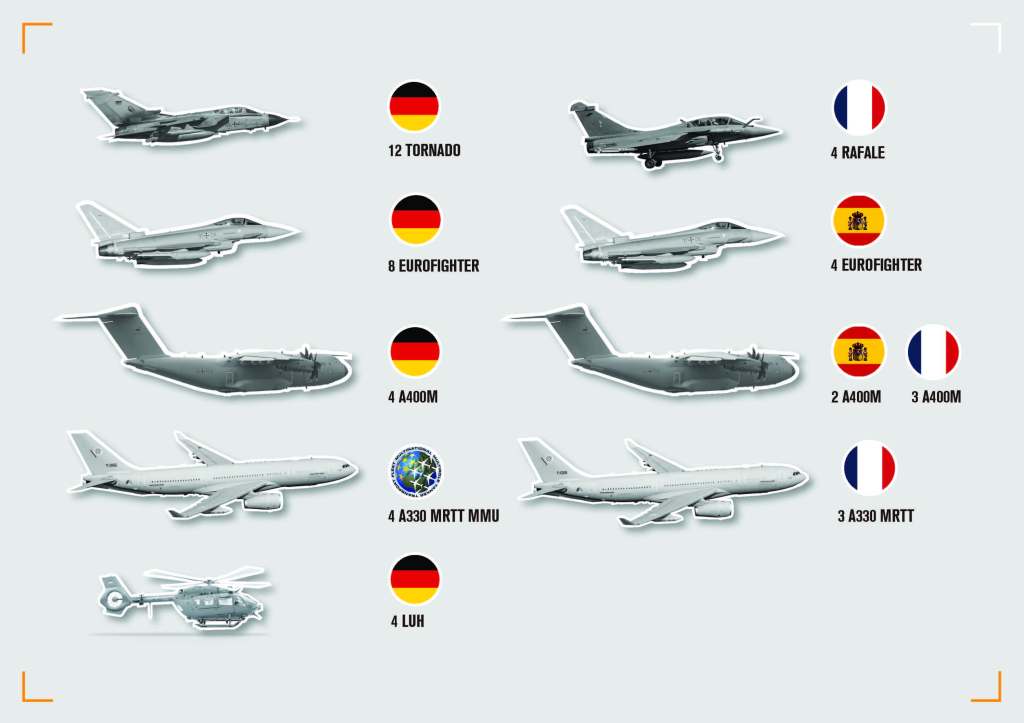Air forces from Germany, France, and Spain are embarking on an unprecedented exercise that will take a variety of combat aircraft to the Asia-Pacific region in a multi-legged journey that will see them work together and with other air arms. With much attention consumed by the strategic implications of the war in Ukraine, Pacific Skies 24 reiterates that the ‘pivot to Asia,’ driven above all by China’s increasingly assertive military stance, also applies to Europe’s NATO allies, at least to a degree.
Tomorrow, assets taking part in Pacific Skies 24 are scheduled to begin leaving Europe, heading first over the Atlantic to the United States, for participation in Exercise Arctic Defender in Alaska.
The main aircraft contingent for Pacific Skies 24 comprises eight German Eurofighters, four Spanish Eurofighters, four French Rafale fighters, 12 German Tornado strike aircraft, nine A400M transports (four German, three French, two Spanish), one Spanish A330 transport, and four German H145M helicopters. All these will be supported by around 1,800 military personnel from those three countries.

Providing aerial refueling support will be four A330 Multi-Role Tanker Transports (MRTT) from the Germany-based portion of the Multinational MRTT Unit (MMU) in Cologne and three more A330 MRTTs from France.
For the German Luftwaffe, this is the last opportunity to expose the Tornado to an international exercise. The swing-wing jets have already arrived in Alaska to take part in low-level training before joining Arctic Defender in early July. This will be primarily an air-to-air combat exercise, including live-firing, with undisclosed U.S. military fifth-generation fighters taking part alongside the three European air forces. Time is running out now for the German Tornados, which will be replaced by F-35As in the nuclear strike role and by specially equipped Eurofighters in the electronic warfare role.


After Arctic Defender, the Pacific Skies 24 deployment will continue westward over the Pacific to Japan, to take part in another exercise, Nippon Skies. These maneuvers will see German Eurofighters train for the first time in Japanese airspace.
Next, the German contingent will split, with some assets heading to Hawaii, for the next edition of the RIMPAC exercise, in which the German Navy is also involved.
The rest of the German deployment will leave Japan for Australia, to engage in the storied Pitch Black exercise, alongside the French and Spanish Air Forces. The large-scale Pitch Black maneuvers are set to involve as many as 20 different types of aircraft from 20 countries.


Finally, Pacific Skies 24 participants will head to India for the first-ever Tarang Shakti 1 exercise, billed as the Indian answer to Red Flag. Also taking part will be the Indian Air Force and the U.K. Royal Air Force. A key facet of the exercise will be the first chance for Spanish fighter pilots to conduct dissimilar air combat training with Russian-designed Su-30 Flanker fighters.
By the time the Pacific Skies 24 deployment arrives back in Europe, slated for August 15, they will have covered around 36,000 miles and have had the chance to train in icy, desert, and tropical environments. Among the other countries in which stopovers are scheduled are Canada, New Zealand, Malaysia, and the United Arab Emirates, among others.

Separate from Pacific Skies 24 will be another French contingent, gathered for Griffith Strike, under which three Rafales, three A400Ms, and three A330 MRTTs will travel to Australia, via the United Arab Emirates and Singapore. They will be accompanied by a U.K. Royal Air Force detachment.
The air forces of Germany, France, and Spain are all currently engaged in modernization efforts, driven at least in part by hikes in defense budgets that have been secured to make their militaries better able to respond to the changing security environment in Europe. This has been largely driven, of course, by Russia’s full-scale invasion of Ukraine.
While Pacific Skies 24 shifts the emphasis from Europe to other operating areas, in the Asia-Pacific region, officials have noted that a Russian shadowing of some kind is expected during the transit between Alaska and Japan. Here, the aircraft will pass over the Pacific Ocean, close to Russian airspace.
“It is envisaged that Russian aircraft will approach and intercept us,” said Lt. Gen. Francisco González-Espresati, the chief of Spanish Air Combat Command. “We’re pretty sure they will, but we’re not worried about it.”
With all three air forces bringing A400Ms and Germany and Spain both operating Eurofighters, the aim is to share maintenance requirements across these fleets as much as is possible, to reduce the logistical footprint. The German and Spanish contingents will leave together from Cologne, further increasing synergies between them.

Stressing the need to practice the rapid movement of aircraft and personnel, as much as possible of the required spares and other logistics supplies will be carried onboard the aircraft taking part, instead of being pre-positioned. For the French contingent, all the necessary materiel will be taken by its A400Ms and A330 MRTTs.
Another interesting aspect of the deployment is the use of a specially equipped French Air and Space Force A330 MRTT, outfitted as a communications relay platform. This will maintain contact with the French Pacific Skies 24 headquarters on the ground in Lyon, France, via satellite link. The expansion of the tanker-transport’s mission set is something that France has been working on for some time and parallels similar efforts involving the U.S. Air Force’s KC-135 Stratotanker fleet.
The French component also includes a single A400M that will provide search-and-rescue support for the duration of the deployment, responding to any emergencies should they arise. This also reflects the expanding mission portfolio for the turboprop transport, a process that has taken a considerable time.

By the end of Pacific Skies 24, the objective is for the three European air forces to have sharpened their skills but, more importantly, to enhance their cooperation with allies in the Indo-Pacific region.
“By participating in Pacific Skies 24, we as Europeans are showing presence in a part of the world that is of great importance to all of us,” said Luftwaffe Chief of Staff Lt. Gen. Ingo Gerhartz.

By demonstrating their air power and commitment to the region, Pacific Skies 24 reinforces the fact that Germany, France, and Spain also have an eye on the strategic picture in the Asia-Pacific region, where the U.S. military and local allies are increasingly adapting their postures and their tactics to face a potential future conflict involving China.
For NATO air forces in Europe, many of which have been hollowed out following post-Cold War defense cuts, and which are only starting to reverse those trends, on a piecemeal basis, a large-scale commitment to a potential future war in the Asia-Pacific theater is questionable. However, it’s significant, even if only in terms of signaling, that the German, French, and Spanish Air Forces are all being mobilized now to not only improve their interoperability with Asia-Pacific allies but also to demonstrate Europe’s strategic ability to deploy a range of aviation assets over significant distances to respond to geopolitical contingencies.
Update, June 27: The German Air Force, or Luftwaffe has announced the arrival in Goose Bay in the province of Newfoundland and Labrador, Canada, of eight German Eurofighters, four Spanish Eurofighters, one German C-130J transport, four A330 MRTTs from the MMU, and two A330 MRTTs from France. The aircraft completed the transatlantic trip in around six hours, with several aerial refuelings.
An earlier tweet from the MMU revealed that the unit provided A330 MRTTs from both its main bases: Eindhoven in the Netherlands and Cologne in Germany.
Contact the author: [email protected]





